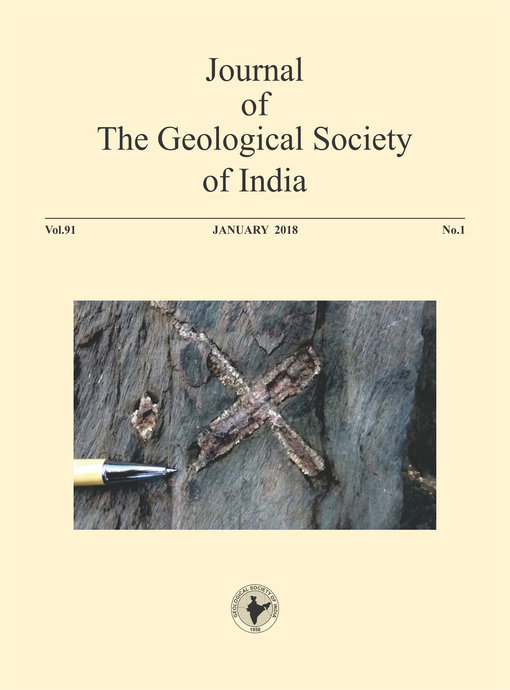Bearing of Structural Anisotropy on Deformation and Mechanical Response of Rocks: An Experimental Example of Rocksalt Deformation Under Variable Compression Rates
DOI:
https://doi.org/10.1007/s12594-018-0826-9Abstract
The deformation and mechanical responses of rocks are prime concern in development of varieties of civil and mining engineering structures. The deformation and mechanical properties of both natural and artificial materials are strongly depend on mineral constituents and their arrangements, temperatures and pressures, stress rates and structural anisotropy. This study elaborates an understanding of structural anisotropy, compression rates and mechanical attributes relationship in rocks with specific examples of deformed rocksalt. The cubical samples (5X5X5 cm3) with three kinds of structural anisotropy were subjected to quasistatic compressive stress at rates 0.00035 MPa/min, 0.0035 MPa/min, 0.035 MPa/min, 0.35 MPa/min, 3.5MPa/min, 5 MPa/ min, 7MPa/min and 9 MPa/min on servo-controlled Material Testing System (MTS). The stress-strain curves prepared from deformation of rocksalt's samples under different rates of compressions are used to determine major mechanical parameters viz., strengths, strains, and modulus of elasticity. A micromechanical en-echelon crack array model is proposed to explain the influence of structural anisotropy on deformation patterns and mechanical properties of rocksalt. According to the proposed model the deformation progresses due to different proportional contributions of tensile and shear crack arrays under the influence of structural anisotropy. The control of structural anisotropy loses with respect to increment in rate of compression with enhance contribution of shear crack arrays in comparison to tensile crack arrays and ultimately fails in shear where the structurally anisotropic rock show isotropic behaviour.Downloads
Metrics
Issue
Section
Downloads
Published
How to Cite
References
Amadei, B. and Savage, W.Z. (1989) Anisotropic nature of jointed rock mass strength. Jour. Engg. Mech., v.115(3), pp.525-542
Amadei, B. (1996) Importance of anisotropy when estimating and measuring in situ stresses in rock. Internat. Jour. Rock Mech. Min. Sci. & Geomech. Abstracts, no.33(3), pp.293-325.
Aubertin, M., Gill, D.E. and Servant, S. (1996) Preliminary determination of constants of an updated version of SUVUC model. In: M. Ghoreychi, P. Berest, H.R. Hardy Jr., M. Langer (Eds.), Proc 3rd Conf. Mech. Behav. Salt. Trans Tech Publ., pp.19–30.
Attewel, P.B. and Sandford, M.R. (1974) Intrinsic shear strength of a brittle anisotropic rock. Internat. Jour. Rock Mech. Min. Sci. & Geomech. Abs., no.11, pp.423–430.
Bidgoli, M.N. and Jing, L. (2014) Anisotropy of strength and deform ability of fractured rocks. Jour. Rock Mech. Geotech. Engg., v.6, pp.156-164.
Carter, N.L., Horseman, S.T., Russel, J.E. and Handin, J. (1993) Rheology of rocksalt. Jour. Struct. Geol., v.15 (9/10), pp.1257–1271
Cristescu, N.D. and Hunsche, U. (1998) Rock Anisotropy, Time Effects in Rock Mechanics, Wiley Series in Materials, Modeling and Computation. John Wiley and Sons, New York, pp.65–183.
Dubey, R.K. and Gairola, V.K. (2000) Influence of structural anisotropy on uniaxial compressive strength of pre-fatigued rocksalt from Himachal Pradesh, India. Internat. Jour. Rock Mech. Min. Sci. & Geomech. Abstr., v.37(6), pp.293–299.
Dubey, R.K. and Gairola, V.K. (2008) Influence of structural anisotropy on creep of rocksalt from Simla Himalaya, India: An experimental approach. Jour. Struct. Geol., v.30(6), pp.710–718.
Horino, F.G., Ellickson, M.L. (1970) A method for estimating strength of rock containing planes of weakness. USBM Rep Inv:7449-26.
Hasselman, D.P.H. and Fulrath, R.M. (1966) Proposed fracture theory of a dispersion-strengthened glass matrix. Jour. Amer. Ceram. Soc. v.49(2), pp.68–72.
Griffith, A.A. (1921) The Phenomena of Rupture and How in Solids,” Phil. Trans. Roy. Soc. London A, pp.163-198.
Griffith, A.A. (1924) The Theory of Rupture. Proc 1st Internat. Cong. Appld Mech., pp.55-63.
Jaroszewski, W. (1984) Fault and Fold Tectonics. Polish Scientific Publishers, Warsawa, Poland, pp.5–12.
Koyi, H. (1996) Salt flow by aggrading and prograding overburdens. In: G.I. Alsop, D.J. Blundell, I. Davison (Eds.), Salt Tectonics. Geol. Soc. London Spec. Publ., v.100, pp.243–258.
Koyi, H. (1998) The shaping of salt diapers. Jour. Struct. Geol., v.20, pp.321– 338.
Lajtai, E.Z., Carter, B.J. and Duncan, E.J.S. (1994) En'echelon crack-arrays in potash salt rock. Rock Mech. Rock Engg., v.27(2), pp.89–111.
Lama, R.D. and Vutukuri, V.S. (1978) Handbook on mechanical properties of rocks. Trans Tech. Publ. III: pp.209-323 & pp.383-388.
Lewis, J.J.M. (1988) Outcrop-derived quantitative models of permeability heterogeneity for genetically different sand bodies: SPE Paper 18153 presented at the 63rd Annual Technical Conference and Exhibition of the Society of Petroleum Engineers, Houston, Texas, Oct 2-5, pp.449-463
Liu, D-M. (1997) Influence of porosity and pore size on the compressive strength of porous hydroxyapatite ceramics. Ceram. Int., v.23(2), pp.135– 139.
McLamore, R. and Gray, K.E. (1967) The mechanical behaviour of anisotropic sedimentary rocks. Trans. Amer. Soc. Mech. Engg., Series B, pp.62–76.
Morland, L.W. (1976) Elastic anisotropy of regularly jointed media. Rock Mechanics, v.8(1), pp.35-48
Nasseri, M.H.B., Schubnel, A., Benson, P.M., Young, R.P. (2009) Common Evolution of Mechanical and Transport Properties in Thermally Cracked Westerly Granite at Elevated Hydrostatic Pressure. Pure Appld. Geophys., v.166, pp.927–948.
Nickser, M. and Martin, C.D. (2013) Crack initiation stress in low porosity crystalline and sedimentary rocks. Engg. Geol., v.154, pp.64-75.
Palchik, V. (1999) Influence of porosity and elastic modulus on uniaxial compressive strength in soft brittle porous sandstones. Rock Mech. Rock Engg., v.32(4), pp.303–309.
Renner, J., Evans, B. and Hirth, G. (2000) On the rheological critical melt percentage. Earth Planet. Sci. Lett., v.181, pp.585-594.
Wagh, A.S., Singh, J.P. and Poeppel, R.B. (1993) Dependence of ceramic fracture properties on porosity. Jour. Mater. Sci., v.28(11), pp.3589–3593.
Weijermars, R. (1979) Progressive deformation in anisotropic rocks. Jour Struct. Geol., v.14, pp.723–742.
Yin, P., Wong, R.H.C. and Chen, K.T. (2014) Coalescence of two parallel preexisting surface cracks in granite. Internat. Jour. Rock Mech. and Min. Sci., v.68, pp.66-84.

 R. K. Dubey
R. K. Dubey






